Article
History Takes Flight at California's Aviation Museums
Author(s):
Southern California has a long aviation history, both civilian and military. And there's no better way to witness and commemorate our country's airborne accomplishments than to visit the region's many aviation museums.
Photography by the author. The near-perfect weather that brought the movie makers to Southern California 100 years ago also pleased others playing with another contraption: The flying machine. Southern California has a long aviation history, both civilian and military. San Diego, for example, celebrated its Centennial of Naval Aviation in February 2011, with a fly-past of 189 aircraft, the last being an armada of 35 in formation.
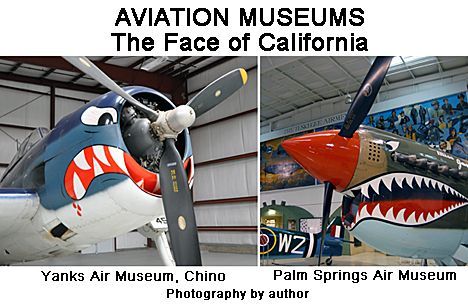
Former military bases scatter the land in the Golden State, but those who enjoy the private flying of so-called “general aviation” are captivated to find even lesser known places have their aviation museums.
In fact, there are two air museums in this city. The San Diego Air & Space Museum is easily found in Balboa Park. San Diego is proud of its connection with Charles A. Lindbergh -- the Spirit of St. Louis, which flew the first nonstop flight from New York to Paris, was built here in 1927 and the city’s airport is named after him. A replica of Lindbergh’s plane has pride of place in the rotunda of the museum. The replica is actually the museum’s second, as the first (which had actually flown over Paris in 1967 at the Paris Air Show) was destroyed by an arsonist in 1978. The original, of course, hangs in the Smithsonian National Air and Space Museum in Washington, DC.
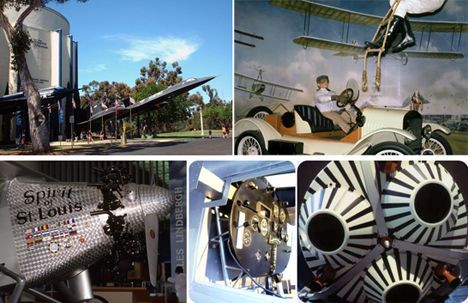
The San Diego Air & Space Museum covers the very beginnings of flying and continues on though the barnstorming era, aircraft in war and the U.S.’s successes in space.
About 10 miles north, the Marine Corps Air Station Miramar sits on a vast flat acreage with laid out, in the open, the Marines’ planes of battle: The Flying Leatherneck Museum.

Top left, clockwise: Grumman Wildcat; North American PBJ-1J (B-25) Mitchell; Douglas Skyhawk A4; Sikorsky CH-53A/D Sea Scallion; Mikoyan-Gurevich MIG 15 Fagot; McDonnell Douglas RF-4B Phantom II. Miramar bustles with energy but the U.S. Air Force’s March Air Reserve Base has seen busier days. It is the home of the 452 Air Mobility Wing. As with the Flying Leatherneck Museum, visitors should check the website first and call if they hope to visit.

The courtyard’s memorials include a tribute to the Lockheed P-38 Lightning and a bust of General James Harold “Jimmy” Doolittle, the American hero who led his pilots off the USS Hornet to bomb various targets in Japan in 1942. A Douglas A-26 Invader stands guard beyond: the attack aircraft was the last plane to bomb North Korea, dropping its bomb load three minutes before the cease fire in 1953.
There’s not much going on at the Museum of Flying in Santa Monica at the moment. The museum was originally established in 1974 by the Douglas family with its signature airplane: the original Douglas World Cruiser that circumnavigated the globe 50 years earlier. The museum has moved twice and is doing so again. Both website and the museum are under construction.
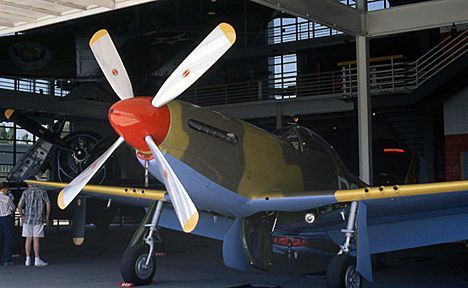
One of the homes of Warbirds, it had a great collection of fighter aircraft -- and visitors never knew if they were going to see a Supermarine Spitfire or more likely, a North American P-51 Mustang poking its nose out of a hanger.
Palm Springs has a lot going for it: interesting museums; the long-established Palm Springs Follies; the world’s largest rotating aerial tramcar that goes way up China Canyon, (even in summer, bring a jacket); and a neat little airport with an intriguing air museum.
The Palm Springs Air Museum is run largely by ex-war veterans, and there is a powerful sense of the past here, of duty and of service, and of sacrifice. The Palm Springs Air museum also pays tribute to the Tuskegee Airmen, and to the military nurses whose skills were vital to caring for wounded bombing aircrews.
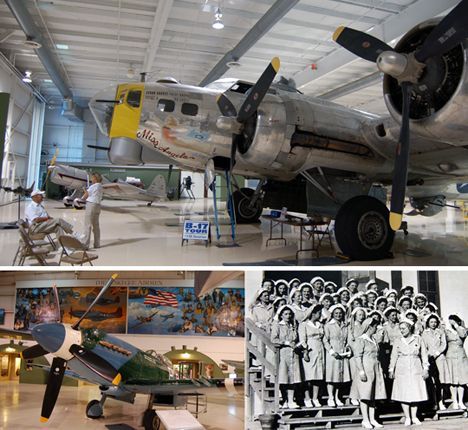
The Boeing B-17 the Flying Fortress always commands attention. Developed in the 1930s, it became the American long-range workhorse in Europe. The plane was able to take punishment but of the 17 Medals of Honor received by its crew members, 11 were given posthumously.
Chino, a small city of about 70,000 people, lies 40 miles east of Los Angeles. Its little airport figured large in World War II. In Chino, aviation enthusiasts get a “twofer”: Two air museums stand side by side on the airport, one Planes of Fame and the other, Yanks Air Museum. Between the two museum sits perky little Flo’s Café, which has served Chuck Yeager, the famous fighter and test pilot; Harrison Ford, the well known actor; and Zsa Zsa Gabor, who was, of course, famous for being famous.
Edward T. Maloney began his Planes of Fame museum here with seven planes he’d rescued from the scrapyard in 1957. It was the first permanent aviation museum in the Western U.S. and the first museum to fly its aircraft, something now done by many flying museums around the world. The museum now has more than 150 aircraft of all types, and three dozen are flyable.
The main focus is the airplane in World War II, though it has a few from the first World War. The museum has a flyable Mitsubishi Zero and a static display Mikoyan-Gurevich Fresco MiG 17. It has WWII military vehicles, too, and the locals are evidently used to seeing a Sherman tank rumbling along the farm lanes.

Exhibits vary from a 1903 Wright Flyer replica to a mockup of an Apollo Command module that shows how little room the three astronauts had on their way to the moon.
The Planes of Fame museum has a satellite museum in Valle, Az., 25 miles from the Grand Canyon. Many of the museum’s 268 volunteers are working on aircraft restoration projects, including one on a Bell P-59A Airacomet and an Aichi D3A2, which when completed will be the only flying examples of the planes in existence.
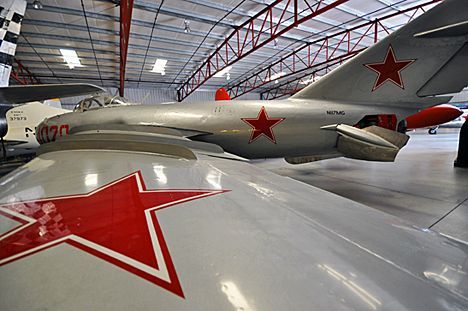
The MiG 17 looks all business. The Soviet interceptor was widely used by the North Vietnamese in the VietNam War. The MiG was slower than American fighters but it wasn’t designed to fight superior American planes, just intercept the slower bombers. Its maneuverability made it successful against opposing aircraft.
Like its neighbor, the Yanks Air Museum focus is showing what the U.S. has built over the last 100 years. With 170 planes over 10 acres, it is the largest private collection of American WWII fighters and dive bombers in the world.
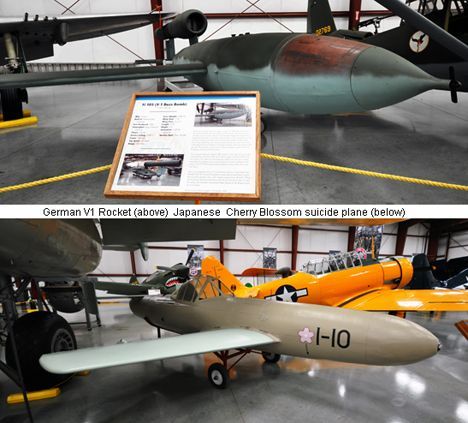
Only two of the Yanks Air Museum’s planes are foreign but they are surely interesting: the V1 Doodlebug flying bomb that Hitler and Goering designed to bring London to its knees, and the Japanese Yokosuka MXY-7 “Ohka 11 Cherry Blossom” kamikaze plane.
Yanks offers visitors another experience: Its restoration wing open to visitors. The museum was started by Charles and Judith Nichols in 1973, who were developing a lumber, property and industrial business in town. They started with a single plane, a Beech Staggerwing.
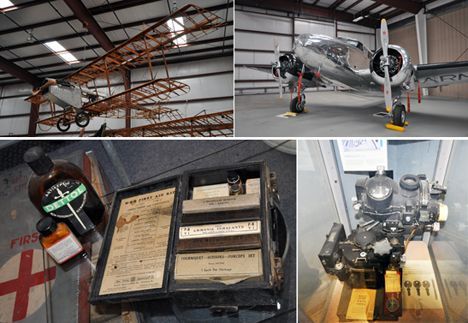
A Curtiss JN-4D Jenny (90 horsepower, top speed 75 mph) hangs above you as you enter the first hanger. The basic U.S. Army trainer for WWI for 95% of all American pilots, it became the basis of the barnstorming age after the war. The plane, favored by Amelia Earhart and used in her final flight, the UC-40A Electra Jr., sparkles farther into the hanger. It was the first all-metal, twin-engine aircraft built by Lockheed, and in 1936 it was the fastest transport plane in the world. In another hanger, a Norden Bombsight competes with an aviator’s somewhat skimpy First Aid Kit.
There is a lot to look at and there’s never enough time at the Yanks Air Museum. There is, however, a lot of room to move around the planes. Another Lockheed, a P-38 Lightning is standing tall. With twin booms and twin engines the Lightning had literally twice the power of its predecessors. And it was a P-38 that exacted vengeance on Admiral Yamamoto in 1943, payback for his planning Pearl Harbor.
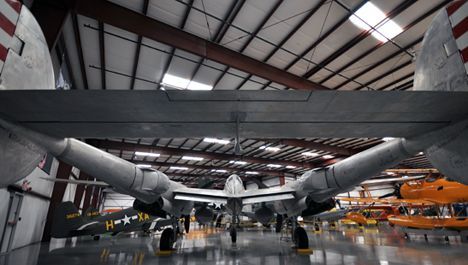
When standing under this P-38, it’s hard for any aviation enthusiast not to recall the death of the French author and pioneer aviator, Antoine de Saint-Exupéry. He was flying a P-38 on a photography mission off the south coast of France on July 31, 1944. In March 2008, a former Luftwaffe fighter pilot, Horst Rippert, claimed to have opened fire on Saint-Exupéry’s aircraft, and that the plane subsequently crashed into the sea.
Eric Anderson, who lives in San Diego, is one of the resident travel & cruise columnists for Physician's Money Digest. The one-time president of the New Hampshire Academy of Family Practice, Eric is the only physician in the American Society of Travel Writers. He has also written five books, the last called The Man Who Cried Orange: Stories from a Doctor's Life.




